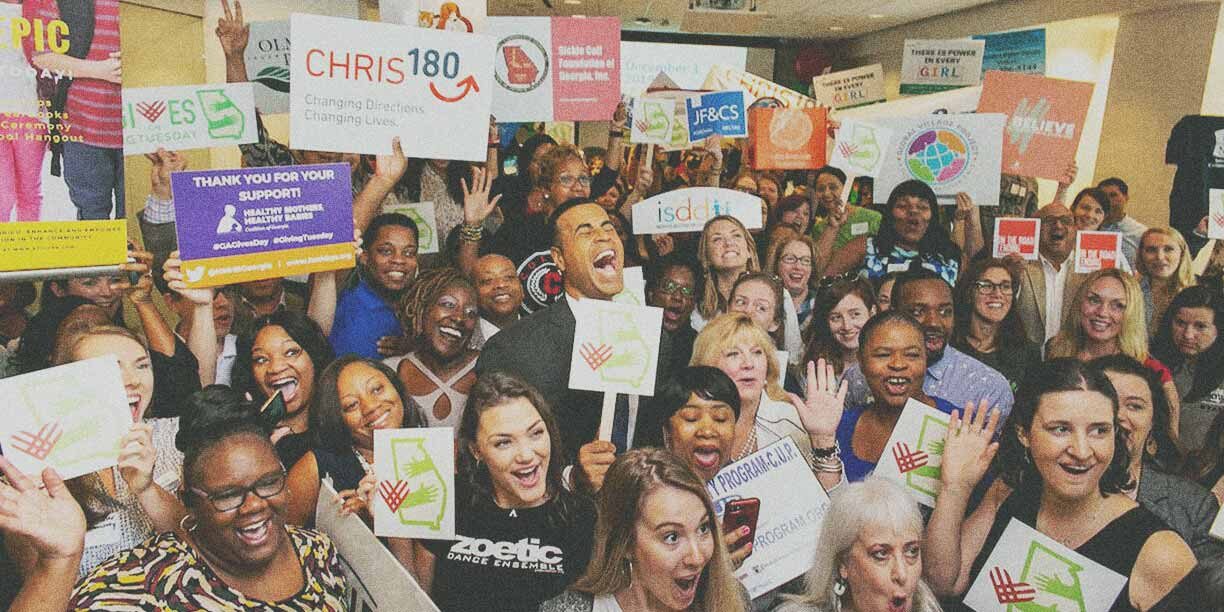Volunteer Training for Better Nonprofit Events and Increased Engagement

Request a Demo
Learn how top nonprofits use Classy to power their fundraising.
Volunteers are a vital piece of the social impact sector. They may assist with your 5K charity run, provide weekly administrative support to your staff, or interact directly with your beneficiaries. Volunteers also often staff nonprofit events, helping balance the many moving parts.
By interacting with donors and guests at these events, volunteers become representatives of your brand. After all, their every action affects the way attendees perceive your nonprofit.
Bottom line: Volunteers help your nonprofit organization do more than it could alone.
But like any team member, they need onboarding, training tools, and support to enjoy their volunteer time and help your nonprofit make an impact. When you educate new volunteers about your organization and prepare them for their duties, you can ensure they have a positive experience and represent your nonprofit well.
Below, we’ll dive into the key components of volunteer management and how they increase volunteer retention rates. We’ll also cover applying these principles to volunteer orientations, specifically for events. This ultimate guide to volunteer training will help you turn volunteer learners into passionate leaders.
4 Steps for Training Volunteers and Increasing Engagement
From the moment you begin volunteer recruitment, start thinking about volunteer retention. After all, each step you take in your new volunteer training and onboarding process helps volunteers feel welcomed and confident in their responsibilities.
1. Onboard Volunteers to Your Mission and Vision
Training opportunities should start with showing how volunteer work relates to your mission. Ensure all volunteers know your vision, operations, and strategic plan. When you explain what volunteers help you achieve, you also make volunteer service more satisfying. Volunteers who gain a sense of accomplishment from their work are more likely to help again.
That’s why new volunteers should receive an onboarding orientation, particularly if they’ll represent your organization to donors and the public. Your orientation should cover your:
- Organization’s mission
- Primary programs
- Case studies demonstrating your impact
- Volunteer opportunities
- Basic safety instructions and rules
- Volunteer hours documentation procedures
- Frequently asked questions (FAQs)
With this information, volunteers know what you seek to accomplish, how you make an impact, and what they can do to help. If you need to onboard several volunteers, prepare a short webinar or volunteer manual to deliver these details.
Nonprofits frequently recruiting volunteers can even set up a monthly orientation meeting or online training to regularly bring new supporters up to speed.
2. Build Effective Volunteer Training Courses by Role
While initial onboarding helps volunteers understand your mission and work, you should also provide in-person, interactive training on the tasks they’ll perform.
Either at orientation or on their first day, assign mentors to show volunteers their tasks. And remember, even if something seems basic to you, it may be new to the volunteers. Training sessions at the beginning save questions, mistakes, and time later.
Training is also easier to manage when you clearly define volunteer roles and learning objectives. When you know exactly what someone will do, you can provide the proper training materials. For example, volunteers helping with your social media will need to know how to log into your accounts and where to find approved photos for posting.
Also, ensure your volunteers know who their supervisor is. They should always be able to get in touch with a staff member. And while you’re at it, encourage them to ask questions if they’re unsure about something.
3. Connect New Volunteers’ Skills to the Right Opportunities
Although volunteers are a great resource for delegating simple tasks, they can also bring unique experiences and skills to your organization. Use sites like LinkedIn, Catchafire, or Idealist to list volunteer positions and recruit people with specialized skills, such as web design or grant writing.
When assigning special projects, incorporate volunteers’ past experiences with the skills required for the projects to use their talents. It’s also crucial to brief volunteers on how your organization approaches the specific responsibility. For example, if a writer offers to help your marketing department produce blogs, they must understand your voice and tone.
After working with an engaged volunteer for some time, you may even let them take charge of a project or initiative. They might have an interest in a particular area or an idea to improve the way you operate.
4. Recognize Your Volunteers’ Contributions
After you’ve onboarded volunteers to your mission, walked them through their specific responsibilities, and matched them to the best opportunities, there’s one more key step to ensuring success: show your appreciation.
Take your volunteer engagement strategy to the next level by finding creative ways to recognize the time and care your volunteers provide your nonprofit. You could:
- Give them a shoutout on a local podcast or radio station
- Highlight them on social media throughout National Volunteer Month in April
- Throw a special event on April 20 for Volunteer Recognition Day
- Send them a birthday or thank-you note to show you care
- Include them in your nonprofit annual report
Use volunteer management software to keep track of your volunteers’ anniversaries with your nonprofit and other facts about them to strengthen your relationship.
5 Ways to Prepare Volunteers for Event Support
Events require a lot of volunteer support. Below, we’ll cover the four steps required to properly prepare your volunteers for the big day and show you ways to apply each step specifically for event volunteers.
1. Ensure Volunteers Know How to Speak About You
Volunteers are representatives of your nonprofit brand, so ensure they know how to talk about your organization with authority during an event. No matter their skill level, all volunteers will require a refresher before speaking to guests. Make sure each can explain:
- Your mission statement
- Why you exist
- Your event’s purpose
- How you’ll use donations from the event
Document these answers and email them to volunteers to reference before the event. In your message, break these answers down into a one- or two-sentence tagline, followed by a more detailed description. This way, when a guest asks about your organization, volunteers have a concise, on-brand answer with an in-depth explanation for longer conversations.
2. Run Through the Event Schedule and Goals
It’s also a good idea to remind volunteers they’re not just helping hands—they’re a part of your team. Facilitate this by ensuring they’re clear on your event’s goals. Share details with them, such as:
- How the event will impact your mission
- How many new donors you hope to acquire
- How you plan to engage with major donors
- How you plan to foster ongoing community
- Why you’ve chosen these goals for this event
When volunteers feel like valued members of your team, they’re more likely to adopt your goals. Simply put, sharing this information makes them feel included in your mission.
You should also give a run-through of the event schedule and email it to your volunteers so they can reference it. In it, inform them when to arrive, where to check in, and when everything will end. Also, let them know if there’s a dress code.
3. Prep Volunteers for Event FAQs
Your volunteers will likely receive many logistical questions at the event. Prepare them to respond to any scenarios that may arise. Cover possible inquiries about parking, restrooms, the check-in process, food allergies, seating, and the venue.
Also, train volunteers on how to handle difficult or unexpected situations. For example, what happens if a pre-registered guest’s name doesn’t appear on the guest list? If you’re hosting a wine-tasting event, how should volunteers respond when a guest brings a child? Everyone benefits when your staff and volunteers feel ready and capable.
Most importantly, ensure your volunteers know who to contact for other questions, concerns, or emergencies.
4. Break Down Roles and Responsibilities
It’s also a good idea to assign volunteers to tasks based on their skill sets and interests. After covering general event information, divide your volunteers by role and offer specific training opportunities.
For example, if you have a volunteer in charge of accommodating a speaker or special guest, give detailed instructions on managing them. If you station a volunteer at the door for your fundraising gala, train them on how to greet attendees, process pre-registrants versus walk-ups, and use your payment processor.
The event will go much smoother if you give volunteers their assignments and train them to succeed at their specific tasks ahead of time.
5. Thank Volunteers After the Event
Saying thank you goes a long way. So after your event, send your volunteers a letter or host a special appreciation gathering to express your gratitude. Let them know how well the event did toward meeting your goals and remind them that they played a critical role in that success. This will help build long-lasting relationships and increase their likelihood of volunteering again.
To demonstrate that you value their opinions, you can also send them a follow-up survey to find out what they enjoyed, whether they felt prepared to do their jobs, and how you can improve their experience in the future.
Establish an Effective Volunteer Training Program for Increased Event Support and Volunteer Retention
Volunteers are a mainstay in the nonprofit sector, and for good reason. A devoted volunteer can give thousands of hours to your organization over a lifetime and make a huge impact on your cause. When you treat volunteers well and give them the tools they need to succeed, they can strengthen your team, support your events, and help advance your mission.

The Fundraising Event Experience Report
Subscribe to the Classy Blog
Get the latest fundraising tips, trends, and ideas in your inbox.
Thank you for subscribing
You signed up for emails from Classy
Request a Demo
Learn how top nonprofits use Classy to power their fundraising.


